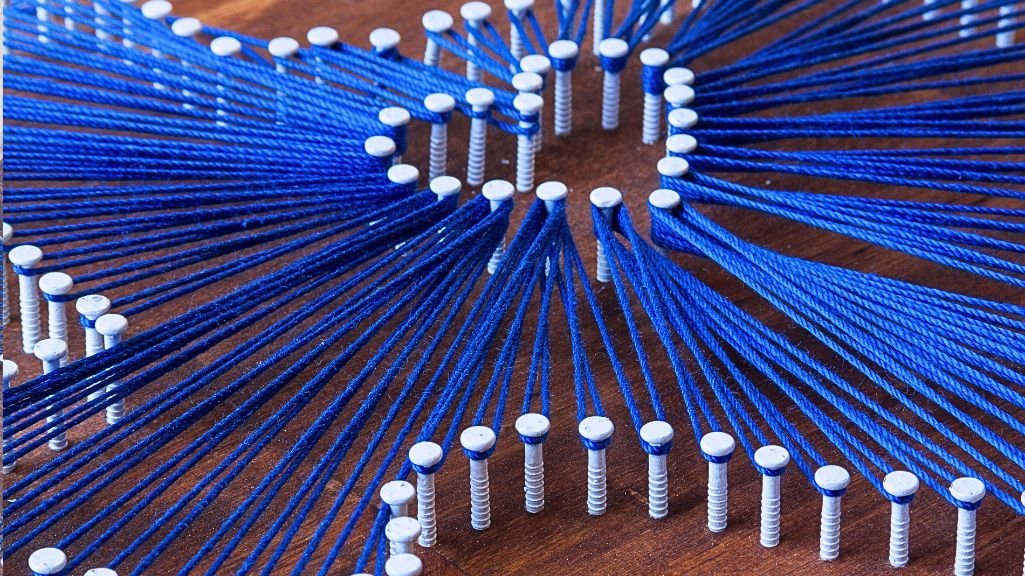Table of materials
String art is the creation of patterns using threads stretched between nails. It involves placing nails on a surface to craft geometric or figurative artworks. This simple technique, accessible to everyone, allows for the creation of unique and personalized designs. As such, wire art is perfect for giving original gifts or decorating walls. It offers endless possibilities. This guide will outline the steps and tips for exploring this captivating artistic practice.

Article Summary:
String art is a creative activity accessible to everyone, involving weaving threads around nails to create original 2D or 3D works.
Necessary materials:
- Choose a solid base,
- Thin nails,
- Thread,
- A hammer,
- A template using pencils, paint, and a guide to assist with the creation.
Steps to follow: Start by attaching a nail with thread. Tie knots to ensure precision and tension. Follow the established template while maintaining a steady rhythm!

1. Materials required for thread art
1.1. The basics of String Art
To begin the craft of filmmaking, one must first create straight lines, curves, or even detailed portraits. You may easily transfer your model to the selected support by using a crayon. Before you begin your creation, add a personal touch by putting your support.
For the material, you need:
- You should choose a suitable support, such as a thick cardboard, a piece of wood, or a counter.
- Get rid of the nails. Prioritize thin-headed nails.. An appropriately sized pin can help make manipulating small nails easier.
- Let your imagination run wild with different types of fabric, such as linen, cotton, or broder.
- Employing a sturdy hammer is essential for precisely fixing the nails.
- Possess a selected model printed on a piece of paper with construction points. The model that is selected may be a drawing, a photograph, or an online image.
First, place the nails, making sure to space them evenly. A large number of nails will make your design more precise. Next, attach your wire to a starting nail, then carefully wrap it around the others. Make sure you respect the pattern. Finish your creation by tying the wire firmly before admiring the final result.

2. The steps to thread art
2.1. Choose your motif
To get inspired, check at websites like Pinterest, which have a wealth of diverse examples to spark your imagination. Furthermore, geometric themes like mandalas or polygones are a great starting point for beginner projects.
Start with simplicity: Start with basic motifs like the triangle, circle, and square. With this, you will gradually become proficient in this artistic skill.Prior to tackle more sophisticated creations later on. This will help you become more knowledgeable and precise.

2.2.Transfer the motif onto the substrate
A well-defined motif ensures a finished product that is intricate and elegant. It is possible to use drawing software to make it faster. This enables you to create customized models. With this, you may print these models at the desired size to use as a guide for your creations.

2.3. Weaving step by step
Miniature linen tensioners may be quite helpful in ensuring a regular tension of the thread. Several nodes procedures allow for the solidification of each piece of film while maintaining its aesthetic appeal. Additionally, weaving offers a relaxed experience where it’s crucial to enjoy every moment.
By altering the film’s tension, one can add depth by creating zones that are either more or less dense. To create relief effects, experiment with the colors and thicknesses of the film. Your motif will gain depth and complexity if you use multiple different color schemes.

2.4. The different weaving techniques
Choosing an aléatoire tissage is advisable if you want a more natural and unstructured effect. One can select for a spiral tissage: Start in the motif’s center to achieve this. Next, turn it toward the outside for a dynamic effect. For a zone-based weaving, each zone of the motif is gradually filled in for a harmonious and well-organized result. Don’t be afraid to combine these approaches to create original and distinctive visual effects.

3. Tips and tricks for yarn art
3.1. Errors to avoid
Make sure that every nails are pressed at the same depth for a consistent tension if you want to master the craft of filmmaking. To preserve the support’s form, it’s crucial to avoid relying too much on it. For a net result, choose nails that are appropriate for the thickness of the thread and the material of your support.
3.2 Personalize your creations
Don’t be afraid to experiment with different materials, such as metal wire or pearls, to enhance your creations. Create your own motifs or alter pre-existing images to suit your aesthetic. You can create one-of-a-kind pieces by combining string art with other techniques like painting or collage.

4. String art: Creativity and Relaxation at your Fingertips
String art and filmmaking are more than just creative hobbies; they are shared passions. Regardless of your level of experience, there are countless opportunities to create original works of art. You can find a wealth of inspiration by browsing social media and specialized platforms. In addition to being aesthetically pleasing, this practice fosters patience, focus, and creativity. She also provides a calm and meditative experience. Don’t wait any longer; let your creativity run wild and embark on the String Art adventure!
Did you find this article useful? Like and share to help other artists
generative art: from…
One fascinating aspect of digital art is generative art. It uses computer programs to create works of art on its…
Why order a…
Who wouldn’t want to get a portrait that captures the very essence of who they are? A portrait transcends a…
Digital art gallery…
Digital art, born from technological advancements, has reshaped global artistic landscapes. While the West pioneered this movement, Africa, particularly Cameroon,…

Author
Explore African culture through the lens of Mba Verlaine, a passionate Cameroonian artist sharing reflections on art and traditions!




